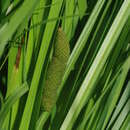fi
nimet breadcrumb-navigoinnissa


Der Amerikanische Kalmus (Acorus americanus) ist eine Sumpfpflanze, die in den Vereinigten Staaten und Kanada heimisch ist.
Diese ausdauernde krautige Pflanze erreicht Wuchshöhen von etwa 80 cm. Direkt aus den Rhizomen entspringen die hellgrünen, schwertförmige Laubblätter, die an der Basis scheidenartig ineinander liegen. Ferner haben die Blätter zwei bis sechs angehobene Adern und eine verdickte Mitte, wenn sie im Querschnitt betrachtet werden. Das Laub hat ein zitrusähnliches, würziges Aroma und kann verwendet werden, um Bier zu würzen.
Es handelt sich um eine Blütenpflanze mit unauffälligen Blüten, die auf einem scheinbar seitenständigen Kolben (einer verdickten, fleischigen Blütenstandsachse) angeordnet sind. Die Früchte dieser Art weisen ein geleeartiges Inneres auf. Der Amerikanische Kalmus wird in Pennsylvania als gefährdet eingestuft und ist geschützt.[1]
Der Name „Acorus“ wird vom griechischen Wort akoron hergeleitet. Dioscurides gebrauchte dieses in Ableitung von koreon (= Pupille), weil Kalmus in der Kräutermedizin zur Behandlung von Entzündungen des Auges verwendet wurde.
Der Speziesname americanus zeigt einfach an, dass dieses eine amerikanische Art der Gattung ist, die von der sehr ähnlichen europäischen und westasiatischen Spezies Acorus calamus, dem gemeinen Kalmus zu unterscheiden ist.
Der Amerikanische Kalmus wurde früher als Acorus calamus L. var. americanus Raf., Acorus calamus var. americanus (Raf.) H.Wulff eingestuft. Jedoch zeichnet sich Acorus americanus durch einen diploiden Chromosomensatz (2n = 24) aus[2], während Acorus calamus eine triploide, regional sterile Sorte ist (2n = 36), die sich in Mitteleuropa nur asexuell verbreitet.
Diese Pflanze wurde von amerikanischen Ureinwohnern und frühen europäischen Siedlern genutzt.
Als eine diploide Art der Gattung Acorus enthält sie kein β-Asaron.[3] Asaron ist ein möglicher Vorläufer in der Synthese des psychedelischen Phenethylamins TMA-2. Diese Chemikalie ist einer der Gründe, weshalb von Kalmus abgeleitete Produkte als Nahrungsmittelzusätze in den Vereinigten Staaten verboten wurden.
Der Amerikanische Kalmus (Acorus americanus) ist eine Sumpfpflanze, die in den Vereinigten Staaten und Kanada heimisch ist.
Acorus americanus, the American sweet flag, is an emergent wetland plant native to the northern United States and Canada. This perennial plant has bright green blade-shaped leaves that arise directly from the rhizomes and sheath into each other at the base. Additionally the blades have 2-6 raised veins, and a swollen center when viewed in cross section. The foliage has a citrus-like spicy aromatic quality, and can be used to flavor beer. It is a flowering plant with inconspicuous flowers that are arranged on a lateral spadix (a thickened, fleshy axis) and the fertilized flowers produce berries with a jelly inside. This plant is protected as a state endangered species in Pennsylvania.[1]
The name "Acorus" is derived from the Greek word 'acoron', a name used by Dioscorides, which in turn was derived from 'coreon', meaning 'pupil', because it was used in herbal medicine as a treatment for inflammation of the eye.
The species name, "americanus" simply indicates that this is an American species of this genus, differentiating it from the very similar European and western Asian species Acorus calamus.
Acorus americanus was formerly classified as Acorus calamus var. americanus. It differs only in being a fertile diploid (2n = 24)], whereas most of the A. calamus of Europe and Asia is a sterile triploid species, that only spreads asexually. Diploid plants in northern Asia may be representatives of A. americanus.[2] Also as a diploid it does not produce β-asarone.
This plant was used extensively by Native Americans and early European settlers.
In 1968 the Food and Drug Administration banned Acorus calamus from being used as a food additive and as a medicinal as a result of lab studies that involved supplementing the diets of lab animals over a prolonged period of time with massive doses of isolated chemicals (β-asarone) from the Indian Jammu strain of Acorus calamus. The plant was labeled procarcinogenic.[3][4][5] Wichtl says "It is not clear whether the observed carcinogenic effects in rats are relevant to the human organism."[6] However, most sources advise caution in ingesting strains other than the diploid strain.
Like the diploid strains of Acorus calamus in parts of the Himalayas, Mongolia, and C Siberia, the Acorus americanus diploid strain does not contain the procarcinogenic β-asarone.[7][8][9] Research has consistently demonstrated that "β-asarone was not detectable in the North American spontaneous diploid Acorus [Calamus var. Americanus]".[10]
It is believed by some that calamus is a hallucinogen. This urban legend is based on two pages of a book written by Hoffer and Osmund entitled The Hallucinogens. The information on these two pages came from anecdotal reports from two individuals (a husband and wife) who reported that they had ingested calamus on a few occasions.[5][11] None of the components in calamus are converted to TMA (trimethoxyamphetamine) in the human organism.[11] To date there is no solid evidence of any hallucinogenic substances in Acorus calamus.
However, for Native Americans, specifically the Alberta Cree, it has been reported that "the root {was} chewed for the hallucinogenic effects,"[12] so perhaps more investigation is needed.
Calamus shows neuroprotective effect against stroke and chemically induced neurodegeneration in rats. Specifically, it has a protective effect against acrylamide induced neurotoxicity.[13]
{{cite web}}: CS1 maint: unfit URL (link) Acorus americanus, the American sweet flag, is an emergent wetland plant native to the northern United States and Canada. This perennial plant has bright green blade-shaped leaves that arise directly from the rhizomes and sheath into each other at the base. Additionally the blades have 2-6 raised veins, and a swollen center when viewed in cross section. The foliage has a citrus-like spicy aromatic quality, and can be used to flavor beer. It is a flowering plant with inconspicuous flowers that are arranged on a lateral spadix (a thickened, fleshy axis) and the fertilized flowers produce berries with a jelly inside. This plant is protected as a state endangered species in Pennsylvania.
Amerikinis ajeras (lot. Acorus americanus, angl. American Sweet Flag) – ajerinių (Acoraceae) šeimos ajerų (Acorus) genties augalų rūšis.
Aukštis iki 80 cm. Nuo pagrindinio stiebo išaugina 2-6 atšakas.
Skleidžia malonų, citrinas primenantį aromatą, todėl ajero sultimis dažnai gardinamas alus.
Amerikinis ajeras naudojamas tiek indėnų, tiek europiečių liaudies medicinoje.